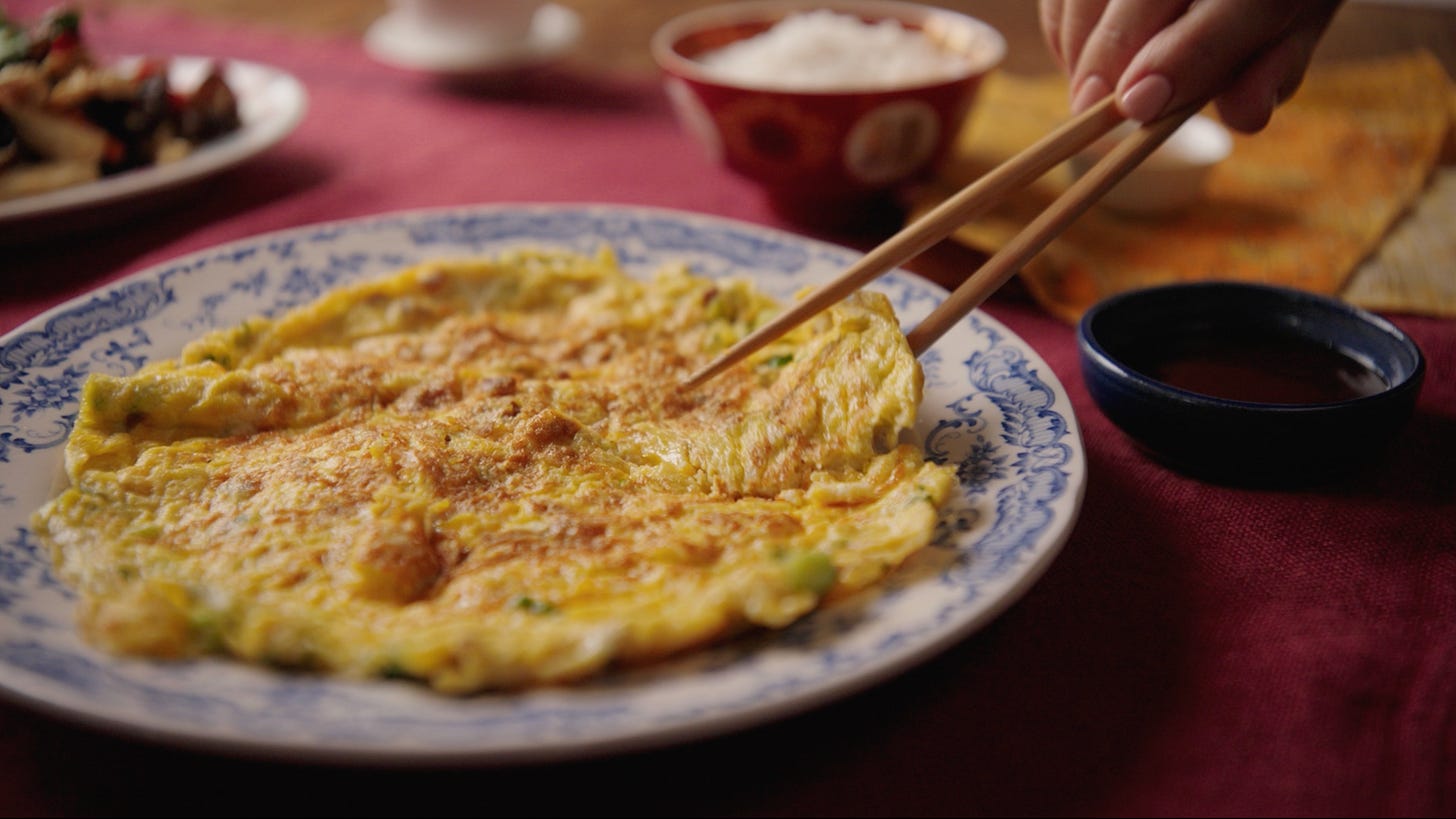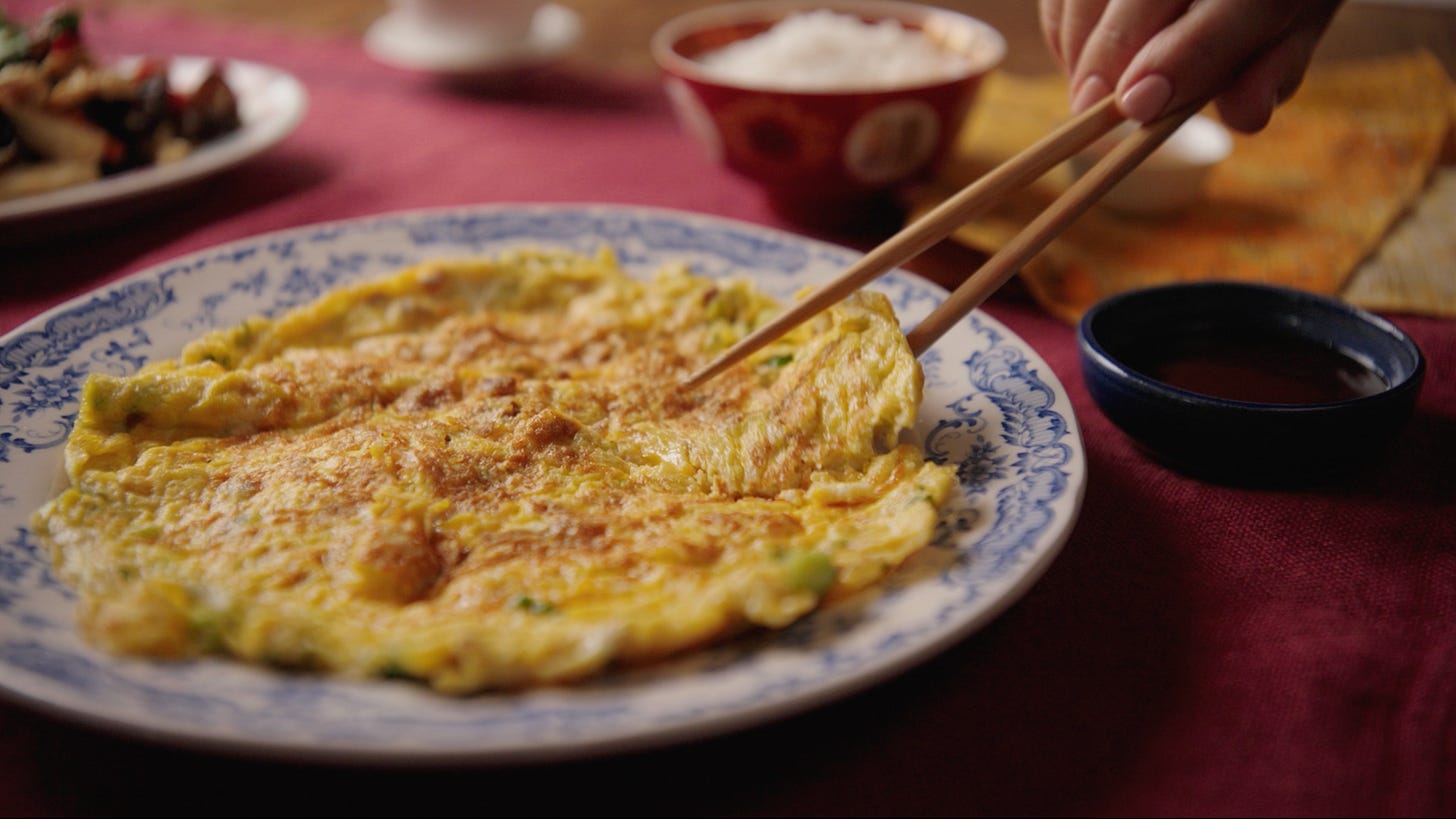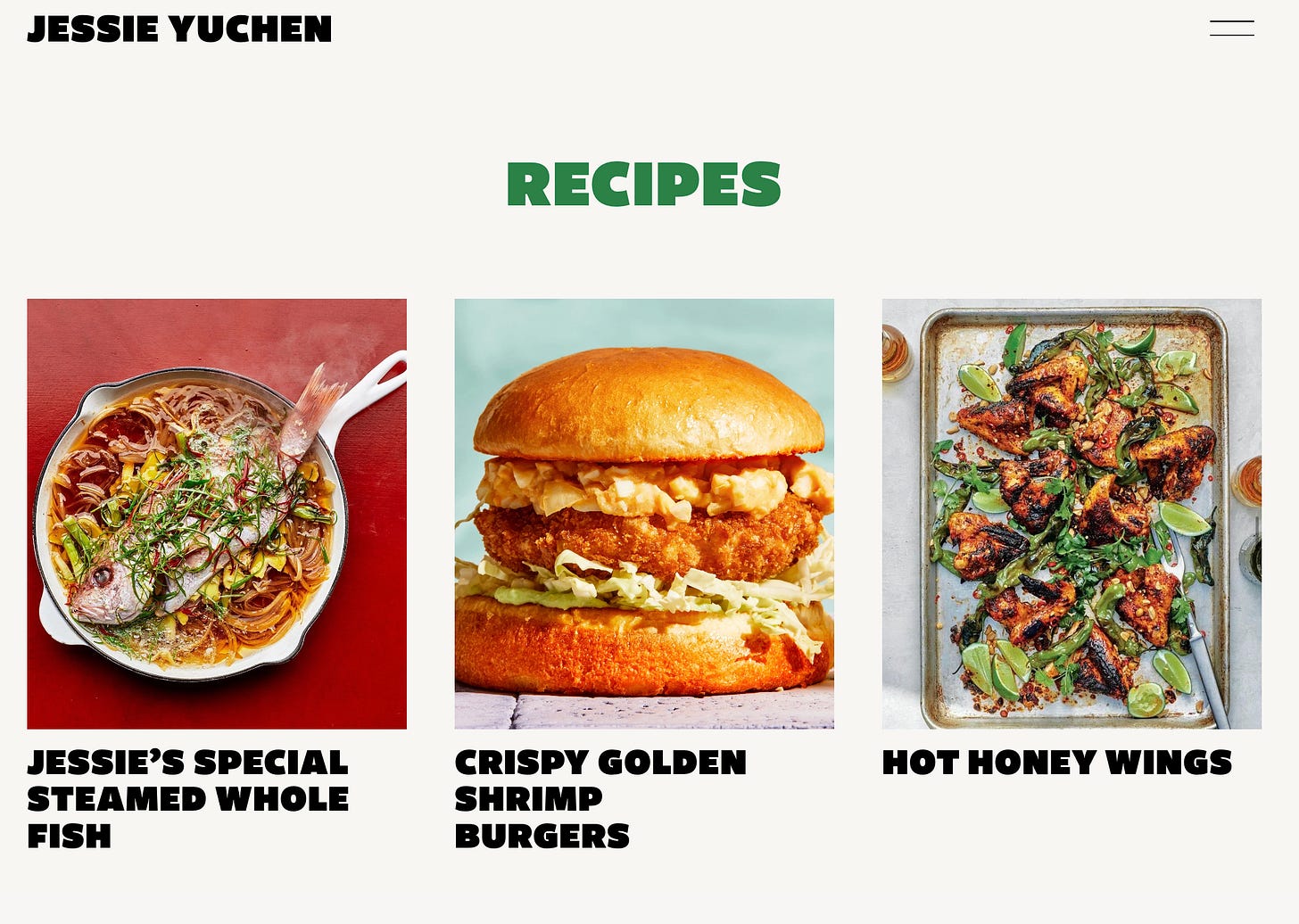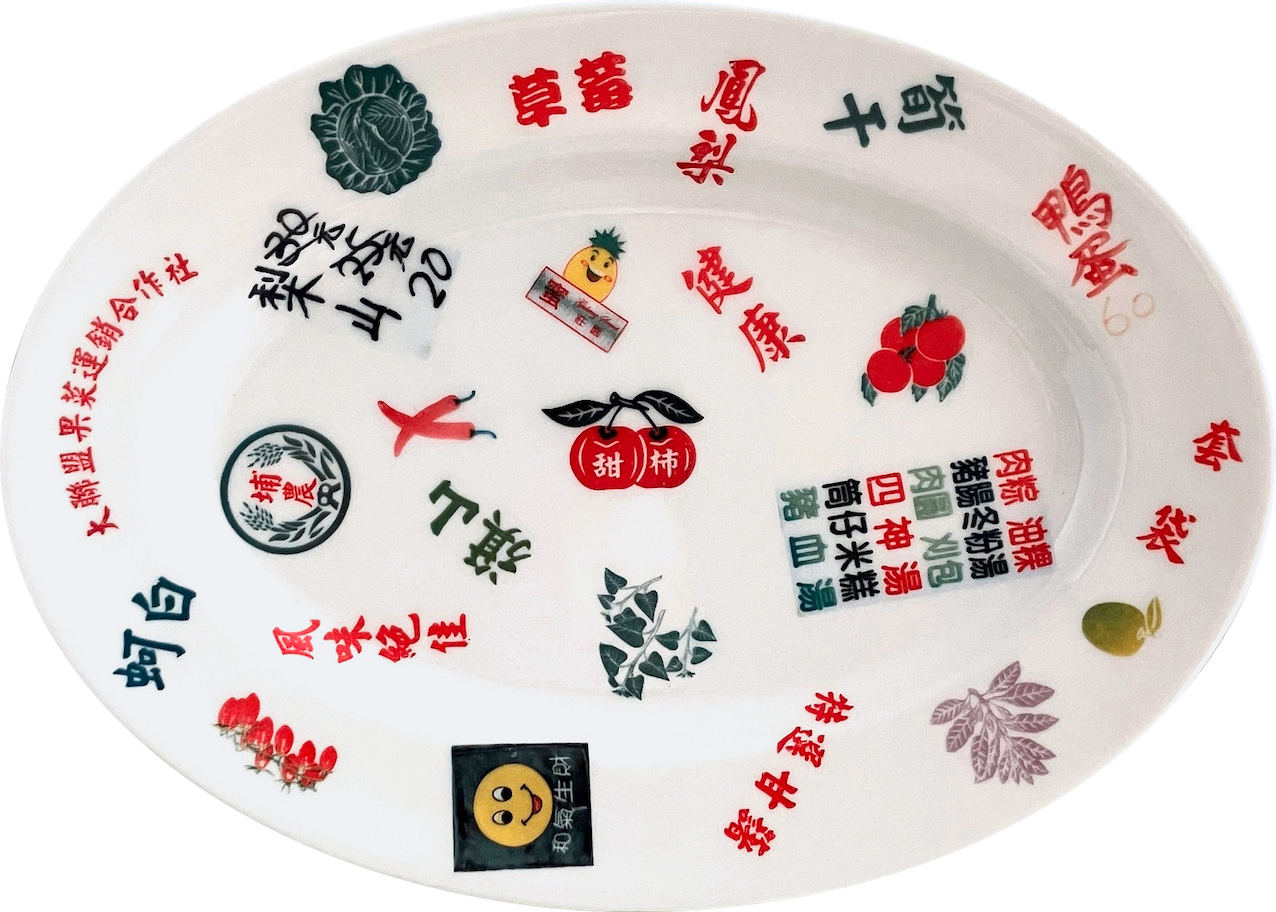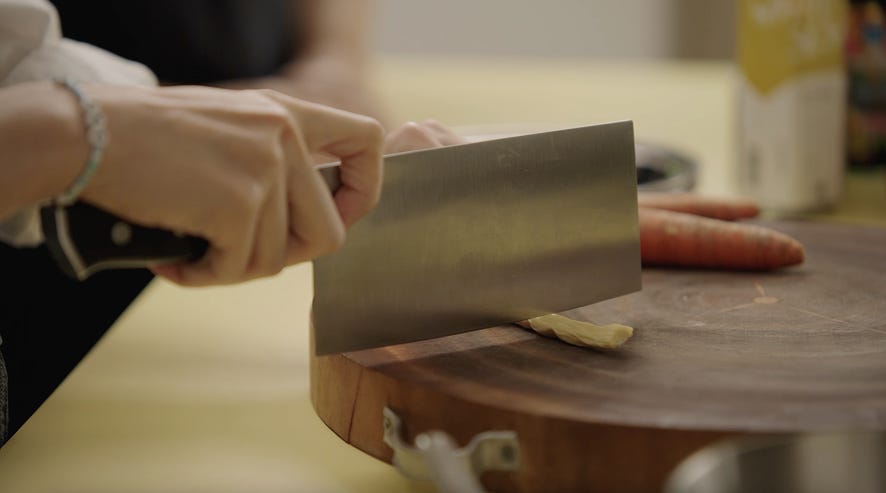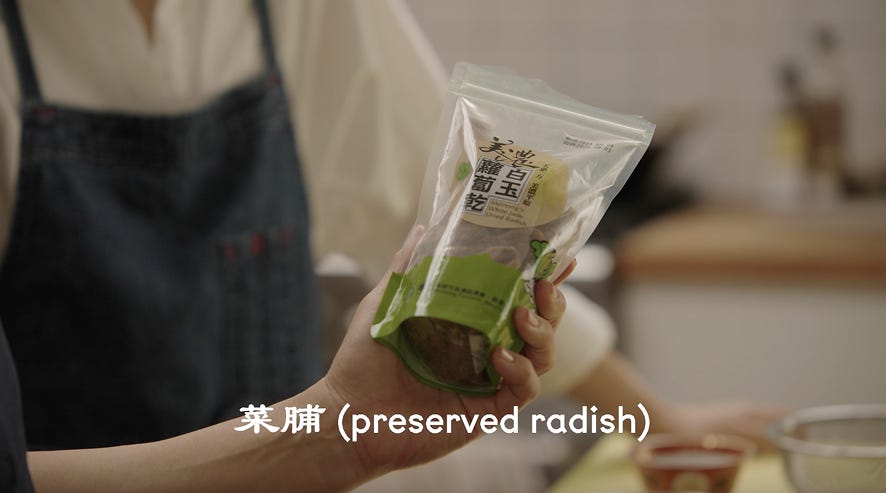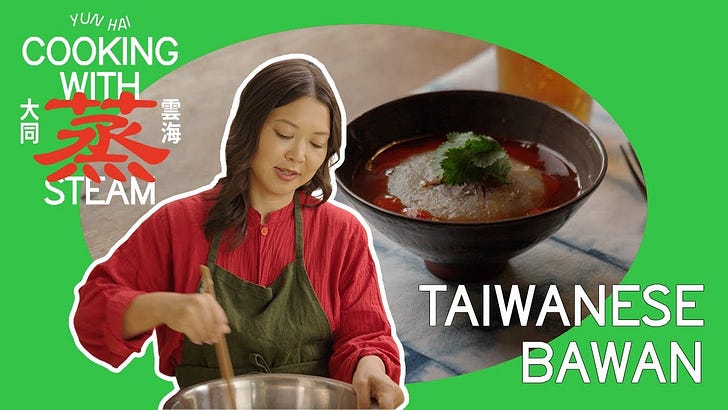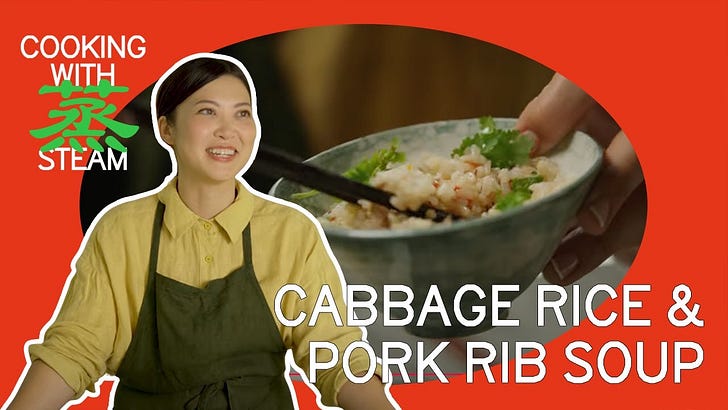Cooking With Steam S2E2: Preserved Radish Omelet with Cold Dressed Yuba Salad
featuring Jessie YuChen, Taiwanese chef and friend of the shop
This is Yun Hai Taiwan Stories, a newsletter about Taiwanese food and culture by Lisa Cheng Smith 鄭衍莉, founder of Yun Hai. If you aren’t yet a subscriber, sign up here.
The second season of our Taiwanese cooking show, Cooking With Steam, explores Taiwanese food through the lens of 古早味 gu zao wei. This phrase translates to “ancient flavor,” but largely refers to pre-war Taiwanese foods that represent a more agrarian diet and, to me, feel especially homestyle.
Episode two of Cooking With Steam Season Two is here! We’re faster on the rollout this time around; getting better every day. Thank you to our producers at Night Shift for making this happen!
This episode is a bit of a departure from previous episodes, as we shift focus from steaming in the Tatung to other Taiwanese cooking techniques. Today, we feature a simple pairing of preserved radish omelet 菜脯蛋 with a cold dressed salad of yuba (tofu skin) and wood ear 涼拌腐竹木耳. This vegetarian pairing comes together in a flash, and, when served with rice, makes a hearty lunch or dinner.
We’re also excited to welcome our first guest: Taiwanese-American food editor, photographer, food stylist, chef, and friend of the shop Jessie YuChen! We’ve been working together for years, and in addition to being an accomplished pop-up chef and Taiwanese food expert, she provides several of our favorite products to our gamadiam. Scroll past the recipes to read more about our longtime collaboration.
COOKING WITH STEAM Season 02 Episode 02
Radish Omelet with Yuba Salad
好蒸氣 第二季 02 | 涼拌腐竹木耳 菜脯蛋
To start, Jessie demonstrates a cold dressed salad she developed for the show. It’s a wonderful counterpoint to the omelet, bringing snappy textures and vibrant flavors to the rich simplicity of the eggs.
This salad recipe is a type of liang ban 涼拌, or cold dressed dish, one archetype of Taiwanese xiao cai 小菜, or small plates. These are sides that accompany the main event, usually found in self-serve fridges at street side eateries and restaurants. At home, many styles of xiao cai can be made ahead and kept in the fridge for a few days. It’s an easy way to fill out any lunch, breakfast, or dinner.
Next, we move onto the main: the preserved radish omelet, a staple of Taiwanese food that reflects the rich contribution of the Hakka people to the cuisine. The word Hakka, or 客家, means “guest families” and reflects the long history of migration and hardship this Han Chinese ethnic group has endured. Originally from parts of Northern China, they migrated southwards and have established themselves across China, Taiwan, Southeast Asia, and overseas communities around the world.
In Taiwan, Hakka communities have contributed a wealth of techniques, ingredients, and preparations to Taiwanese cuisine. This omelet features preserved radish, also known as cai bo 菜脯, a typical Hakka preserve. It lends a savory flavor, meaty texture, and lots of nutrition to any dish it’s used in. You’ll see in the show how Jessie wonders if there’s actually sausage in the omelet; there’s not, it’s just that rich in flavor.
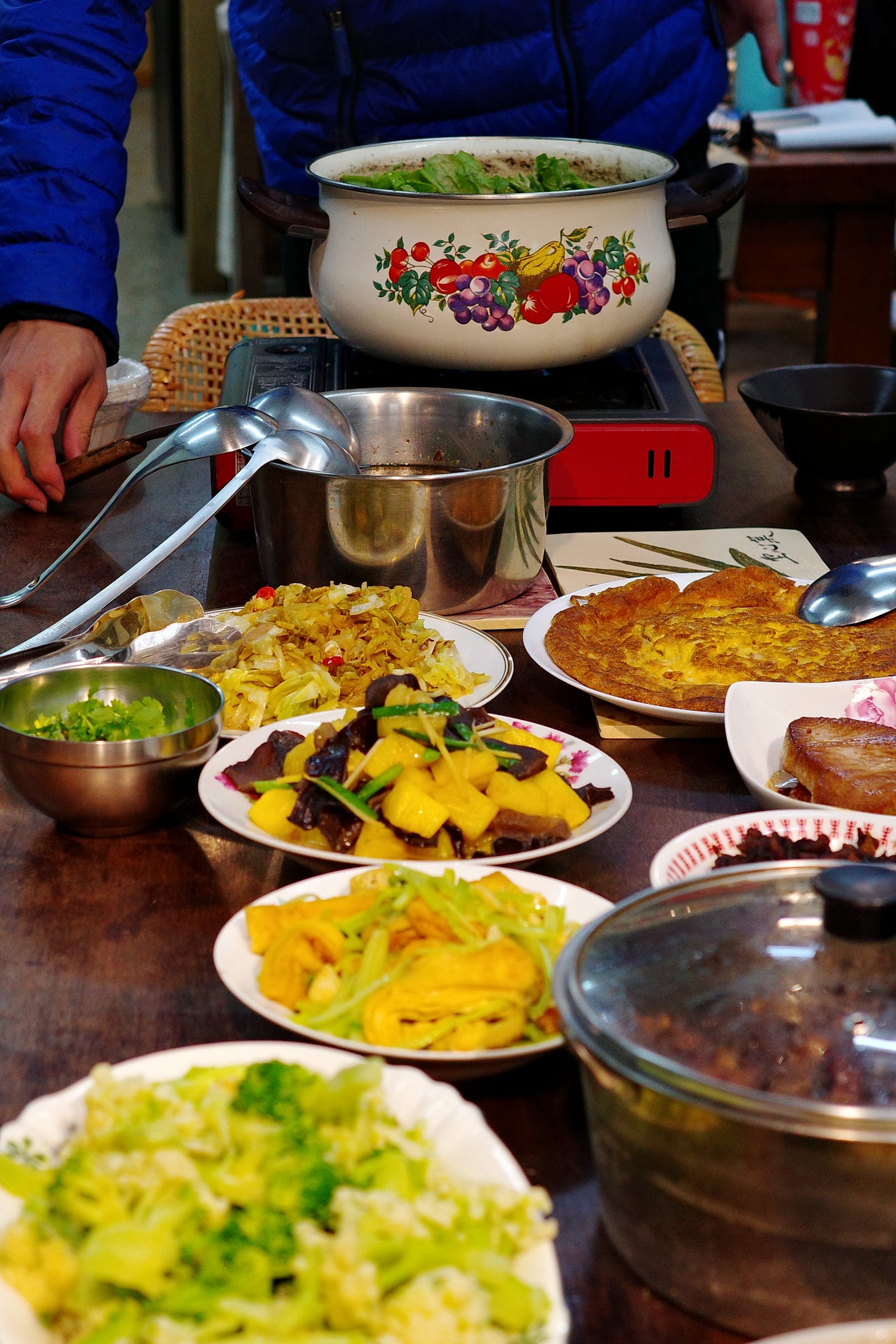
The Recipes
To limit the length of these newsletters, we’ve started publishing full recipes on our website. See below:
Cold Dressed Yuba with Wood Ear
This beauty of this dish (textures! colors! flavors!) masks its simplicity. The key is to prepare all your ingredients carefully and uniformly, then quick-blanch them to sha qing 殺青 or “kill the rawness.” The quality of the ingredients in the dressing matter, too, since they’ll bring almost all of the richer flavors to the dish.
Once you’ve mastered the technique, try varying it on your own. You can do this with other kinds of vegetables and different condiments.
Preserved Radish Omelet with Duck Eggs
There isn’t much to this recipe, as it’s a very simple and typical dish. There are only a few ingredients: eggs, white pepper, a bit of oil, a touch of soy sauce, preserved radish, and a sprinkling of scallion. My recipe features duck eggs, which are optional but provide an extra richness and robustness in texture.
Technique does matter, and I’ll be the first to admit that I’m afraid of omelets. The ultimate custardy omurice feels like it requires the perfect combination of correct pan, properly sized recipe, elbow grease, timing, and technique. I’m constantly disappointing my kids with broken (literally) promises of tornado-style eggs.
I have found, after making very many Taiwanese preserved radish omelets, that they are relatively easy to make, especially if you accept the idea that you don’t need to flip them perfectly to get a beautiful finish. Prioritizing the perfect flip over the perfect result may keep you from the lightest possible texture.
I demonstrate my home-cook-friendly method in the video. First, I fuss around with it a little, breaking the omelet to allow the liquid from the top to run into the bottom. The eventual flip could not even truly be called one, it’s more of a coax. And then there’s a glue-together step where the still liquid egg re-coalesces the disparate parts back into one piece. The end result is elegant, whole, and, more importantly, not overcooked! It’s not going to win any James Beard awards, but it is effective.
A few thoughts on this homestyle method:
If you cook the omelet until it’s easy to flip, it’s likely to fall on the overdone side, especially if you aren’t paying attention, your pan is a little too hot, or your spread is a little too thick or thin.
If you don’t disturb the eggs a little while cooking in the beginning, the eggs on the bottom may cook faster than the rest, potentially browning and filling the kitchen with that overdone egg smell.
If you flip when all the eggs are cooked through but then break the omelet, there may not be any runny egg remaining to fill in the cracks.
It occurs to me that this is not entirely dissimilar to the way Julia Child made a French-style ham omelet on the first season of The French Chef, where she also stirs the omelet to start and recommends shaping it with your hand if it doesn’t turn out the way you want. And of course, she mentions using dirty plates and making a general mess of the mise. What an inspiration.
Meet Jessie YuChen

After graduating from medical school, Jessie transitioned into the culinary world, working in restaurants before discovering a love for photography and food styling. Known for her unapologetic flavors and innovative techniques, Jessie made a mark working at Bon Appétit with her distinctive style. Jessie lives in New York City with her extensive pantry collection.
We’ve worked together on many Yun Hai projects, from one of our earliest Yun Hai pop-ups (Winter Solstice Tangyuan 2022) to food styling our Yun Hai Tatung Family Cookbook. Jessie also produces Boomipop, her house brand of Popcorn Chicken Popcorn (which we sell in our store) and is the brains behind Bubble Team, a Taiwanese craft beer distributor.
Most recently, she’s co-written a Kewpie Mayo cookbook. Not Taiwanese, per se, but we’re very excited about it, given the prevalence of mayo in many Taiwanese snacks! Scroll to the end of this newsletter for more info on that.
We’re constantly impressed by Jessie’s integrity and prolific repertoire, and are so grateful she made time to style Cooking with Steam Season Two and make a cameo on the show. Thank you Jessie!
Ingredients and Equipment
I love to show off my collection of ceramics, props, everyday objects, and kitchen tools on the show, many of them gifted by friends or collected personally over the years. Here’s a little more information on what I used this episode.
The Taiwanese icon-patterned serving plate for the yuba salad was made by Taiwanese artist Hsiang Jung Chen, a precious gift to me from Taiwanese art director and designer Yenwei Liu.
The gray and blue plate used to mise the garlic and chilies was made by Taiwanese-American ceramicist Debbie Carlos. The red speckled dish used to hold the cane sugar was made by Alice W Chai of MAT Ceramics, also a Taiwanese-American ceramicist. The red rice bowl is a vintage ceramic from Tatung. Finally, the blue serving plate for the omelet is not Taiwanese, but was purchased from this lovely shop.
For the recipe, Jessie and I chop using our Maestro Wu Vegetable Cleaver on a round ironwood cutting board, which I purchased from an Asian grocery store in Detroit over 15 years ago. To steam the rice, I use the 6-cup Tatung Steamer.
And, for the recipes, we incorporated a few things from Yun Hai Shop, like preserved daikon radish, pineapple soy sauce, Taiwanese black vinegar, white sesame oil, Su chili crisp, and penglai short-grain rice.
Please reach out with any other questions on sourcing or ingredients. Happy to help, as always.
Gratitude and Acknowledgements
We couldn’t have done this without the support and passion of our friends and community. So much love and gratitude to Night Shift, who produced this, and all our creative collaborators for giving the show its unique voice.

Credits
Produced by Night Shift and Yun Hai
Made possible by Tatung Taiwan
Team:
Lisa Cheng Smith, host
Jessica Wang, guest talent
Jessie YuChen, food stylist & guest talent
Nicole Wang, culinary assistant
Amalissa Uytingco, culinary producer
Sam Broscoe, producer
Alec Sutherland, director & editor
Nathan Bailey, director of photography
Rob Woods, camera operator
Taylor Dekker, camera operator
Alexandra Egan, art director
Kyle Garvey, sound mixer
Jinho Myung, editor
R. Hollis Smith, mix
Rebecca Alexander, hair and makeup
Dustin Wong, music
O.OO, graphics
Jil Tai & Ben Hill, motion design and title sequence
Our Set
Our set features props from Taiwanese, Taiwanese-American, and international friends worldwide, creating those Taiwancore vibes we love so much at Yun Hai.
Thank you for the beauty Mikey Chen, Lillian Li, Emilie Liu, Debbie Carlos, Matthew So, Kelli Cain, Material Kitchen, Mogutable, Felicia Liang, Sam Tilney, Lulu Yao Gioiello, Grace Jung, Eric Sze, Julianne Ahn, Alice Chai, Stephanie Smith, Rio Chen, and Leh Lin.
And much gratitude to our friends who contributed to wardrobe: Everybody World, Judi Rosen, Whimsy and Row, RMS Beauty, and Christine Mai Nguyen.
Special Thanks
Russell Wang, Maggie Chang, Shirley Liu, Ivan Wu, Feng Hsieh, Hollow, Chris, Leon, Simon, Agnes, Jim, Lillian Lin, Jasmine Huang, Natya Regensburger, Jeremy Hersh, Cat Yeh & the entire Yun Hai Team, our partners, and our community.
Before I go, I wanted to share a little more about the Kewpie cookbook we mentioned, co-written by Jessie YuChen with Elyse Inamine and photographed by Heami Lee (another longtime Yun Hai friend and collaborator!).
For the Love of Kewpie (aka The Kewpie Mayo Cookbook) is both a cookbook and history book dedicated to the iconic babyfaced condiment of contemporary Japan. There are 55 recipes across categories, from appetizers like smoked fish dip, to mains like katsu sando, and desserts like lemon cupcakes. If you’re a kewpie-head, like me, you can order your copy here.
Enjoy the food!
Elegant, whole, and, more importantly, not overcooked,
Lisa Cheng Smith 鄭衍莉
Written with editorial support by Amalissa Uytingco, Jasmine Huang, and Lillian Lin. If you enjoyed this newsletter, please share it with friends and subscribe if you haven’t already. I email once a month, sometimes more, sometimes less. For more Taiwanese food, head to yunhai.shop, follow us on instagram and twitter, or view the newsletter archives.
Cooking With Steam: Taiwanese Bawan
The first episode of season two features a traditional Taiwanese dumpling made with sweet potato starch and long-grain rice flour.
Cooking with Steam Episode 03: Cabbage Rice and Pork Rib Soup
My favorite Taiwanese comfort food and a big old tropical storm.







